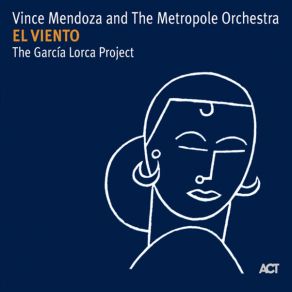El Viento - The Garcia Lorca Project
Download links and information about El Viento - The Garcia Lorca Project by Vince Mendoza, Metropole Orchestra. This album was released in 2009 and it belongs to Jazz, Latin genres. It contains 12 tracks with total duration of 01:10:41 minutes.

|
|
|---|---|
| Artist: | Vince Mendoza, Metropole Orchestra |
| Release date: | 2009 |
| Genre: | Jazz, Latin |
| Tracks: | 12 |
| Duration: | 01:10:41 |
| Buy it NOW at: | |
| Buy on iTunes $10.99 | |
| Buy on Amazon $8.99 | |
Tracks
[Edit]| No. | Title | Length |
|---|---|---|
| 1. | La Canción del Mariquita | 4:18 |
| 2. | Historietas del Viento I: El Viento | 4:40 |
| 3. | Historietas del Viento II: Viento Estancado | 5:19 |
| 4. | Historietas del Viento III: La Brisa | 6:05 |
| 5. | La Tarara | 8:37 |
| 6. | De los Cuatros Muleros | 6:24 |
| 7. | Sevillanas del Siglo XVIII | 3:44 |
| 8. | La Nana del Caballo Grande | 6:11 |
| 9. | Los Peregrinitos | 3:34 |
| 10. | Ángeles Negros | 5:28 |
| 11. | Los Mozos de Monleón | 9:22 |
| 12. | La Leyenda del Tiempo | 6:59 |
Details
[Edit]Vince Mendoza has arranged and composed some of the most startlingly impressive symphonic jazz of modern times, but El Viento might be his most ambitious project. Teamed with the Netherlands-based Metropole Orchestra, Mendoza's idea to make grandiose music based on the persona of poet, playwright, painter, and pianist Federico Garcia Lorca is not only a stroke of genius, but well conceived and executed with the extraordinary talents of this large ensemble. This idea was essentially initialized by Lorca himself in 1931 as the Ur-Lorca Project, formalized in 1979 by vocalist Camaron de la Isla and composer/producer Ricardo Pachon, further formulated by Niko Langenhuijsen and his group Caoutchouc in 1992. By 1998's centennial celebrations of the birth of Lorca, this concept via Langenhuijsen's arrangements had grown into a full-blown fusion of Spanish flamenco, big-band jazz, and Lorca's word play as performed live in Utrecht. Ten years later, the modernized concepts of Lorca (who died in 1936) come to full fruition via Mendoza and Metropole. This was far from a simple feat, as Mendoza's jazz-oriented charts are both beautifully soaring and complex in their development. The band pulls it off brilliantly, with encouragement from the magnificent lead singers Eva de Dio or Rafael de Utrera, expressing the folkloric Spanish style, the cante jondo (deep song), duende fever, and flamenco-inspired music so much a part of this culture. High drama is the key to these compositions, especially during the three-part suite "Historietas Del Viento," composed and arranged by Langenhuijsen. Upper horizon strings and a vocal choir moves to a rich, jazzed samba/flamenco-flavored chart, and the acoustic or electric guitar of Daniel Mendez, with a 12/8 section driving the expressive, emotional singing of De Dio to conclusive heights. Joan Albert Amargos contributes charts of traditional pieces; the spoken word intro to jazz waltz swinger "De Los Cuatros Muleros" and tender "Los Mozos De Monleon" with an oboe or harp respectively brightening things up. Pachon revisits two of his compositions — "La Cancion Del Mariquita" via Mendoza's chart in a majestic and upbeat flamenco as lofty high strings hover over Marc Scholten's Michael Brecker-like neo-bop tenor sax solo, and "La Leyenda Del Tiempo," which again showcases the tenor, this time inspired by dance tap from Daniel Navarro, hand clapping, and a quick, joyous refrain. Two other traditional pieces are adapted by Mendoza, as "La Tarara" uses the most folkish acoustic approach with strings and an excited flamenco-derived pace, while "Sevillanas Del Siglo XVIII" is the group at its most festive, using castanets and a 6/8 shout-out vocal style for purely seductive, fever-pitched purposes. This was originally a 90-minute concert presentation, edited and abridged somewhat here for the CD format. If you are familiar with Lorca's poems, you will certainly hear them come to life on this remarkable recording, but if discovering them for the first time, you can easily be captivated by their beauty, strength, and resolve so much the centerpiece of Spanish heritage, an old world, heartfelt passion that still remains in our modern era. Bravo! ~ Michael G. Nastos, Rovi